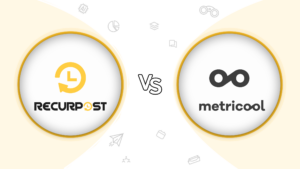Sprout Social vs Buffer
Sprout Social vs Buffer – Which Platform Is Better In 2025?
Which tool is the best? Is it that hard to decide?
If you're stuck between Sprout Social and Buffer, you're not alone. Both offer great features, but the right choice depends on your needs.
No credit card required

Quick Summary: Sprout Social and Buffer
When deciding on the perfect social media management tool, certain aspects, such as features, pricing, reviews, and support, must be evaluated.
Here is the overview of tools:
2 months free with annual billing
Sprout Social overview
Sprout Social, founded in 2010, is a social media management tool designed to help business streamline their social media presence. It offers scheduling posts, managing engagement, a unified social inbox, and team reporting.
Apart from basic features, it also offers robust analytics and reporting features that deliver actionable insights. These insights help businesses understand audience behavior, optimize content strategies, and improve engagement
Users find Sprout Social easy to use and appreciate its interactive interface and robust analytics. However, some users find it a bit pricey compared to similar tools in the market. (Capterra)
Users love the powerful scheduling feature of Sprout Social, which simplifies content planning and enhances engagement. Users also appreciate the ease of scheduling and managing content across multiple profiles, enhancing their workflow efficiency. However, certain limitations like linking issues, high pricing, and missing features in Sprout Social, such as additional channels and scheduling options for Instagram stories, impact their overall user experience and functionality. (G2)
Buffer Overview
Buffer was founded in 2010. Buffer is a social media management tool built to help agencies schedule, publish, analyze, and engage with content across multiple social platforms from one central dashboard. It offers features like customizable posting schedules, draft & approval workflows, and user permissions so teams and clients can collaborate with clarity.
Buffer also provides analytics dashboards and reporting that help agencies track engagement, reach, follower growth, and campaign performance to make data-driven decisions.
Students and professionals highlight Buffer’s simplicity, effective content queue management, and responsive support. A few notes, the platform can feel limited for Pinterest- or visual-first strategies. (Capterra)
Users love the ease of use, post-scheduling feature, and easy creation feature of Buffer, finding it quick and simple for scheduling social media posts. However, the drawbacks include a lack of analytics, limitations in Instagram scheduling, layout issues, and performance issues. (G2)
Rating Comparison
Feature Comparison: Sprout Social vs Buffer
Features
Scheduling & Publishing
Scheduling across various platforms with a collaborative calendar
Queue queue-based calendar with support for almost all major platforms
AI-powered scheduler recycles evergreen content, auto-schedules posts, and suggests best times to publish.
Engagement
Custom inbox views, message tagging, engagement reporting, and saved replies.
Reply to comments, highlight important comments, and possess a unified social inbox.
Unified inbox helps reply faster; smart filters prioritize conversations that need attention.
Collaboration
Custom report branding, Team activity reports, shared publishing calendar, and approval workflows.
Add internal comments to your content, role-based workflow, and reply to comments and messages on their connected social media profiles.
Shared workspaces and approval flows keep teams aligned with role-based access and smart task routing.
Analytics
Customized reports, branded reports, content queues, and paid social performance reports.
Custom reports, audience insights, Audience demographics, and branded reports.
Smart analytics track engagement, reach, and clicks; white-label reports simplify client performance tracking.
AI Features
DM automation, AI caption writer, generates hashtags.
AI assistant writes captions, generates hashtags, and improves clarity
Generates captions, hashtags, bios, and post ideas; predicts performance; automates scheduling and reports.
Pros & Cons: Sprout Social and Buffer
Pros
- Robust analytics and reporting
- Unified Social Inbox
Cons
- Limited customized report generation.
- Occasional delays or glitches in publishing or handling content for multiple accounts.
Pros
- AI caption generator from prompt
- Generates customised and branded reports
Cons
- No AI image generator
- Custom access and permissions only for enterprise-level plans.
Pricing Comparison
Standard
5 channels, 1 user account, and up to 8 profiles
Essentials
5 channels, 1 user account, and up to 10 social media profiles
Starter
2 social profiles, 10 daily posts, 5 recurring time slots
Professional
unlimited channels, 1 user account, and up to 8 profiles
Team
5 channels, unlimited user accounts, and up to 10 social media profiles.
Personal
5 social profiles, 20 daily posts, 10 recurring time slots
Advanced
unlimited channels, 1 user account, and up to 8 profiles
Agency
20 social profiles, 80 daily posts, 40 recurring time slots
Why RecurPost Stands Out
Why RecurPost Stands Out?
RecurPost shines for many users because it combines strong scheduling and content recycling tools with affordability and ease of use. It enables brands to create evergreen content libraries, featuring posts that remain relevant over time, and automatically repost high-performing content, thereby reducing the need to continually develop new content. RecurPost with AI support for content suggestions and “best times to post”, plus features like social inbox (for managing messages/comments from various platforms in one place), RecurPost helps social media teams save time while keeping engagement high.
Compared to Sprout Social, RecurPost offers many similar core features (calendar, scheduling, collaboration) but often at a lower cost, and it includes content recycling and more flexible evergreen content tools that Sprout lacks. Compared to Buffer, RecurPost tends to provide more automation and deeper recycling
Why RecurPost is better!
RecurPost isn’t just an alternative to Sprout Social and Buffer – it’s a smarter choice for businesses that want more functionality at a lower cost.






